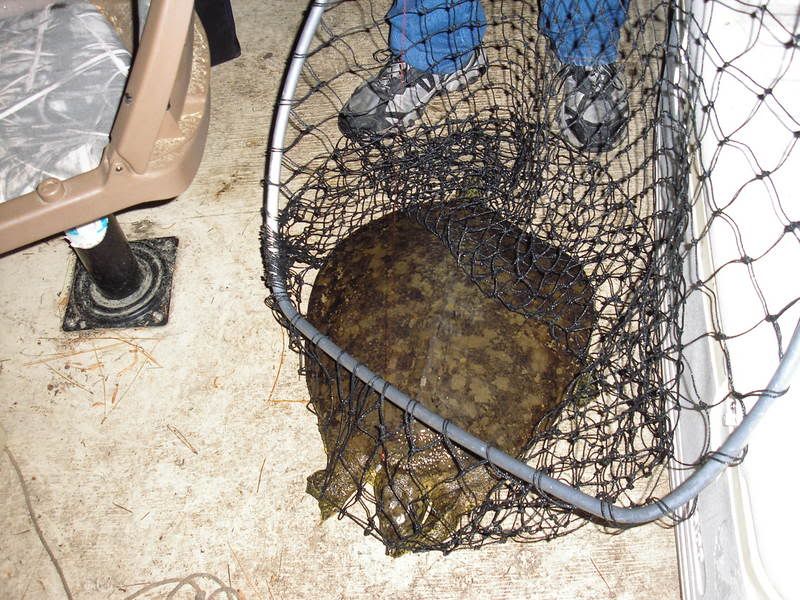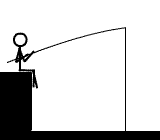|
|
Post by mick on Oct 24, 2008 2:09:08 GMT -5
The Snapping Turtle can grow to a very large size, 20-40 cm on average. It's shell is dark brown, rough and usually covered in algae. The Snapping Turtle can be found in waters ranging from slow moving rivers to stagnate ponds. Although this turtle has received a bad reputation for allegedly biting swimmers and eating baby ducks in reality it is very shy in the water and will retreat from anything except lunch. On land, when threatened it will live up to it's reputation by snapping and hissing while standing on all fours and rocking back and forth. Basically Snapping Turtles eat carrion, their reputation for killing baby ducks could only come from an over abundance or a number of sick baby ducks and only when the Snappers' other food resources are depleted.
Snapping turtles are freshwater turtles that live in the Americas. There are three species: the Alligator, Common, and Florida Snapping Turtles. The Alligator snapping turtle is the largest of the North American freshwater turtles. It may be up to 60 cm long and weigh 90 kg!
Snapping Turtles have large heads which cannot be withdrawn into the small shell. They rely on their strong jaws for defense and can bite hard if disturbed. They live in stagnant ponds, swamps and slow-running rivers. Since the Alligator Snapping Turtle lives mainly on fish, it is slaughtered by fishermen and is now on the endangered list.
Common Snapping Turtles can sniff out carrion (dead animals), which they add to their diet of plants, small birds and fish. They are so fearless and aggressive that on occasion, they have been known to attack swimmers. Because of their unique ability to detect dead and rotting flesh, Common Snapping Turtles have been used to help police search for human corpses!
|
|
|
|
Post by bobberguy on Nov 25, 2008 11:37:51 GMT -5
Long ago I would say 40 years ago there was a barber that would pay like $2.00 for a big turtle. he made turtle soup and it was suppose to be fantastic!
|
|
|
|
Post by Doug on Nov 26, 2008 0:21:07 GMT -5
I have eaten plenty of turtles and they are some good eatin ;D Here is one Scooters Daughter caught last year  Her she is with her 34lb Flathead  |
|
|
|
Post by bobberguy on Nov 26, 2008 1:16:04 GMT -5
That looks like a nice place to fish. Nice fish. you make me want to start boat fishing more!
|
|
|
|
Post by dsmith on Dec 2, 2008 21:25:30 GMT -5
so when you have a turtle circleing your line and just stealing your bait is there anything to do? Probably not, just short of throwing elsewhere. It is frustrating when they are playing with your line.
|
|
|
|
Post by mastercatter on Dec 3, 2008 1:52:12 GMT -5
There is not much that can be done about them bothering bait except either move to another spot or use live bait..
|
|
|
|
Post by dt16 on Dec 3, 2008 17:29:53 GMT -5
bobberguy you get up this way and we'll go boat fishing
|
|
|
|
Post by mick on Dec 7, 2008 4:12:08 GMT -5
Here is my turtle I caught in the summer of 2007. But the BIG one got away because the line broke when I got him on the bank and Bob wouldnt throw him on up lol.... 
|
|
|
|
Post by dsmith on Dec 7, 2008 11:13:53 GMT -5
Hey, is that a Shakespeare combo from Walmart? I had one of those. Wore it out. I actually had the red one and the blue one
|
|
|
|
Post by mick on Dec 8, 2008 14:04:58 GMT -5
yep but I moved up I have 2 open reels now I love them it took a few practice trys then I got it ;D
|
|
|
|
Post by mastercatter on Dec 9, 2008 2:07:36 GMT -5
Since she tried my spinning reels she is really improving on her fishing skills. Now she out fishes me most of the time and catching larger fish. Been trying to get her to post some of her catches from this past summer.
|
|
|
|
Post by mick on Dec 9, 2008 11:48:33 GMT -5
I posted some they are in pics, video topic ;D
|
|
|
|
Post by rockbass on Dec 16, 2008 16:32:18 GMT -5
Good Info in Snapping Turtles! I'm not sure on the accuracy of why the Alligator snappers are endangered though. I always thought it was because of how easy they are to catch and good eatin, not because they were killed for eating the fish  Around here,(Ohio) we have Soft Shells or Leatherbacks as were pictured on this thread already. We also have the Snapping Turtle! Snappers are very good to eat. Leatherbacks are good fried, but the snappers are good fried and in soup. My family actually has a big get together the first weekend of Oct. EVERY year to eat some freshly made turtle soup. We cook it in a huge pot over open fire outside. How does one go about catching turtles you might ask? Well we have all caught them as an unpleasant surprise while catfish...usually on cut bait, chicken liver, or stinkbait. It is far more common in most parts to catch Leatherbacks while catfishing than Snappers, but if you would like to start catching snappers, I have a few tips for ya ;D 1. know the area. If there aren't any snappers in the area, you won't catch them.....hahaha 2. You can set lines for turtles. I usually use a stout hook in the 5/0 range, but going larger is ok. I just found that when I go too big, I end up with more stolen baits than I do hooked turtles  You can use any number of baits ranging from chicken liver to beef. The bait we used most when we set lines was the leg meat from Groundhogs. Farmers liked up killing groundhogs from their fields, and the leg meat was nice and tough so the turtles couldn't just pull it off the hook without a nice fight ending in being hooked. ;D I don't recommend using chicken liver or beef liver, however it does not hurt to add some to the hooks with tougher meat. It just adds to the scent in the water! When setting lines, you can do either set lines from shore, or you can use Jug Lines just like you would for juggin catfish. The easiest and most times most fun ways to line turtles is in someone's pond that wants them gone. Many times even complete stranger will be open to allowing you to set turtle lines. Most people get freaked out by the site of a turtle if they know nothing about them. 3. The Method we use nearly all the time now is.....NOODLING for Snappers. For those that don't know what noodling is...Well, you walk smaller creeks and stick your hand in every hole you find in the bank and holes under rocks, stumps, or in roots. I STRONGLY urge anyone that would want to try something like this to ONLY do it with someone else that has experience. It is a VERY exciting way to catch snappers, but also VERY dangerous. You will no doubt run into snakes and muskrat and other critters when reaching into holes. I won't go into any tricks or anything because there really isn't much to say. One very important thing to remember is to not yank your and away if you get bit. If the turtle didn't let go, you will end up getting hurt. 4. One last tip from me, and I'll stop rambling  If you catch a snapper and you need to carry it, make sure you pick it up by the end of its tail and hold it away from your body. By away, I mean as far away as you can. I have had them bite me through burlap sacks when out noodling them just because I was carrying the bag we put them in and I let it bump up against my leg. |
|
|
|
Post by papa on Dec 16, 2008 17:11:43 GMT -5
I use to catch a lot of snappers but now the way I did it is illegal so I quit. Take a large coffee can and drill a small hole in the bottom, then run a steel leader down through it with your bank line hooked to it, on the other end put a treble hook with your bait, use a float so that when it's in the water the hook with the bait is inside the an and up against the inside of the bottom. Now drill 4 small holes evenly spaced around the open end, using small screws and lock nuts and put treble hooks with two barbs inside the can, cut the one on the outside off, makes it a lot safer handling it. Once the snapper reaches up inside the can to get the bait he will get his neck hooked on one of the four trebles and he will be waiting up on the bank the next day when you go out to check. Due to not being able to get his head out of the can they just come up on the bank. It makes it easy to whack his head off too. It may be legal where you live but not in Illinois, they claim it's cruel, but they were put here to feed us so hope you can use the method and get a bunch.
|
|
|
|
Post by rockbass on Dec 18, 2008 0:00:49 GMT -5
that's an interesting way to do it! I might try that sometime if I get any more ponds to line in. The single hook on a line works pretty good too and would be less work.........but it is something very tempting for when we have troubles hooking the turtles. Have had that happen many time. More empty hooks than hooked turtle  |
|

















 You can use any number of baits ranging from chicken liver to beef. The bait we used most when we set lines was the leg meat from Groundhogs. Farmers liked up killing groundhogs from their fields, and the leg meat was nice and tough so the turtles couldn't just pull it off the hook without a nice fight ending in being hooked. ;D I don't recommend using chicken liver or beef liver, however it does not hurt to add some to the hooks with tougher meat. It just adds to the scent in the water!
You can use any number of baits ranging from chicken liver to beef. The bait we used most when we set lines was the leg meat from Groundhogs. Farmers liked up killing groundhogs from their fields, and the leg meat was nice and tough so the turtles couldn't just pull it off the hook without a nice fight ending in being hooked. ;D I don't recommend using chicken liver or beef liver, however it does not hurt to add some to the hooks with tougher meat. It just adds to the scent in the water!  If you catch a snapper and you need to carry it, make sure you pick it up by the end of its tail and hold it away from your body. By away, I mean as far away as you can. I have had them bite me through burlap sacks when out noodling them just because I was carrying the bag we put them in and I let it bump up against my leg.
If you catch a snapper and you need to carry it, make sure you pick it up by the end of its tail and hold it away from your body. By away, I mean as far away as you can. I have had them bite me through burlap sacks when out noodling them just because I was carrying the bag we put them in and I let it bump up against my leg. 




